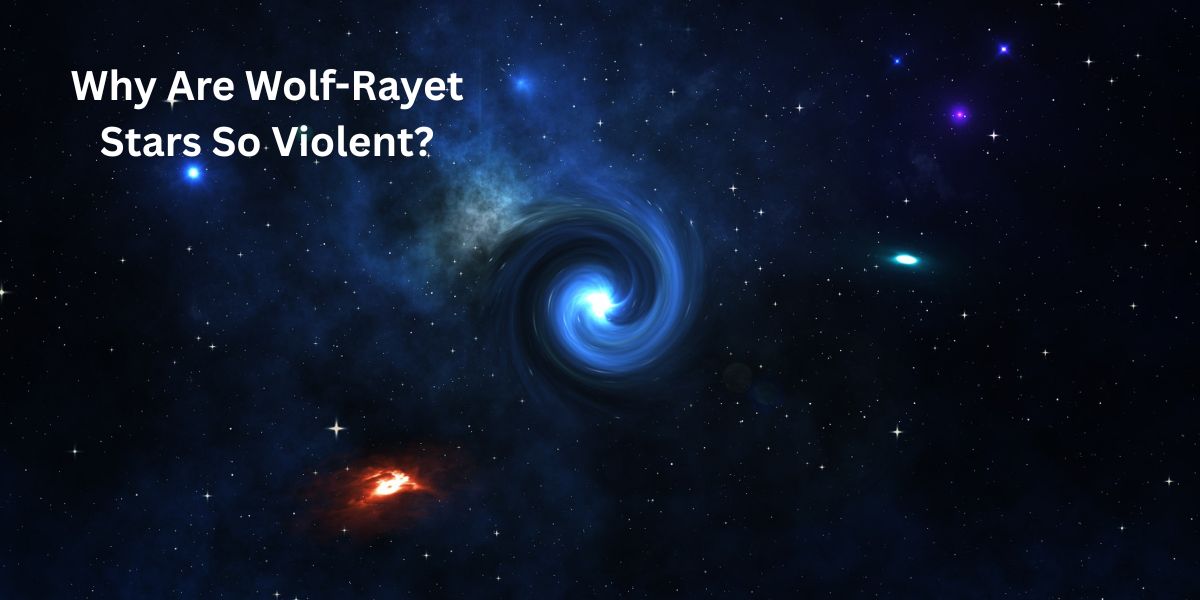Have you ever looked up at the night sky and wondered about the most powerful stars? Some stars shine quietly, while others explode with energy. Wolf-Rayet stars are some of the most violent and extreme stars in the universe. They burn incredibly hot, throw out huge amounts of gas, and live fast, dying young.
These stars are rare but fascinating. They are like cosmic monsters, blasting strong winds into space and shaping the galaxies around them. But what makes them so wild? Why do they behave so differently from other stars? Let’s find out!
What Is a Wolf-Rayet Star?
Wolf-Rayet stars are a special type of star. They are massive, much bigger than our Sun, and extremely hot. Unlike normal stars, they lose their outer layers very quickly, exposing their super-hot cores.
- They were discovered in 1867 by two astronomers, Charles Wolf and Georges Rayet.
- These stars are rare—only a few hundred are known in our galaxy.
- They have strong winds that blow at millions of miles per hour!
Imagine a star that is always shedding its skin, like a snake, but at a much faster and more violent rate. That’s what a Wolf-Rayet star does!
Why Do Wolf-Rayet Stars Lose Their Outer Layers?
Wolf-Rayet stars are so big and bright that they can’t hold on to their outer gas layers. Their intense heat and radiation push the gas away, creating powerful stellar winds.
- These winds can be 10 times stronger than the winds from normal stars.
- The lost gas forms glowing clouds around the star, making them look like they are wearing a fiery cloak.
- Over time, the star loses so much material that only its hot, dense core remains.
This process is like a balloon losing air, but instead of air, the star is losing its own body!
How Hot Are Wolf-Rayet Stars?
Wolf-Rayet stars are some of the hottest stars in the universe. Their temperatures can reach over 50,000 degrees Celsius (90,000 degrees Fahrenheit)—much hotter than our Sun, which is about 5,500 degrees Celsius (9,932 degrees Fahrenheit).
- Their heat comes from their exposed cores, which are full of heavy elements like carbon, nitrogen, and oxygen.
- Because they are so hot, they glow in bright blue or white colors.
- If you could stand near one (which you can’t—it would vaporize you!), it would feel like being inside a giant furnace.
Why Are Wolf-Rayet Stars So Violent?
The violence of Wolf-Rayet stars comes from their size, speed, and energy. They don’t just burn—they explode with activity!
- Strong Winds: Their winds move so fast that they can clear out entire regions of space.
- Explosive Endings: Many Wolf-Rayet stars end their lives in supernovae or even gamma-ray bursts—some of the most powerful explosions in the universe.
- Chemical Factories: They create and spread heavy elements, which are needed for planets and even life!
Think of them as cosmic bulldozers, pushing gas and dust around and changing the space around them forever.
Do Wolf-Rayet Stars Explode?
Yes! Most Wolf-Rayet stars die in huge explosions called supernovae. Some may even produce gamma-ray bursts, which are the brightest explosions in the universe.
- When they explode, they scatter metals and other elements into space.
- These materials later form new stars, planets, and even life!
- Scientists study these explosions to learn how the universe builds new things.
So, in a way, the death of a Wolf-Rayet star helps create new worlds!
Can We See Wolf-Rayet Stars From Earth?
Some Wolf-Rayet stars are visible with telescopes, but they are very rare. The most famous one is Gamma Velorum, located about 1,000 light-years away.
- They are hard to see because they are often hidden inside thick clouds of gas.
- Powerful telescopes like the James Webb Space Telescope help scientists study them better.
- Even though they are far away, their effects can be seen across galaxies.
What Happens After a Wolf-Rayet Star Dies?
After a Wolf-Rayet star explodes, it leaves behind either a neutron star or a black hole.
- Neutron stars are super-dense—a spoonful of their material would weigh billions of tons!
- Black holes have such strong gravity that not even light can escape them.
- The remains of these stars continue to influence space for millions of years.
Conclusion
Wolf-Rayet stars are some of the most extreme objects in the universe. They burn hot, lose material fast, and die in spectacular explosions. But their violence is not just destruction—it helps create new stars, planets, and even the building blocks of life!
How rare are Wolf-Rayet stars?
They are very rare. Only a few hundred are known in our galaxy, the Milky Way.
What is the lifespan of a Wolf-Rayet star?
They live only a few million years—much shorter than stars like our Sun, which live for billions of years.
Can Wolf-Rayet stars support life?
No, their extreme radiation and winds make nearby planets uninhabitable.
What is the difference between a Wolf-Rayet star and a supernova?
A Wolf-Rayet star is a type of star, while a supernova is the explosion that happens when it dies.
Do all massive stars become Wolf-Rayet stars?
No, only the most massive and hottest stars become Wolf-Rayet stars near the end of their lives.
How do Wolf-Rayet stars affect the galaxy?
They spread heavy elements into space, which help form new stars and planets.
What color are Wolf-Rayet stars?
They usually appear blue or white because of their extreme heat.
Can a Wolf-Rayet star become a black hole?
Yes, if it is massive enough, it can collapse into a black hole after exploding.
How fast do Wolf-Rayet star winds move?
Their winds can reach speeds of millions of miles per hour!
Are there any Wolf-Rayet stars close to Earth?
The closest known one is Gamma Velorum, about 1,000 light-years away.
